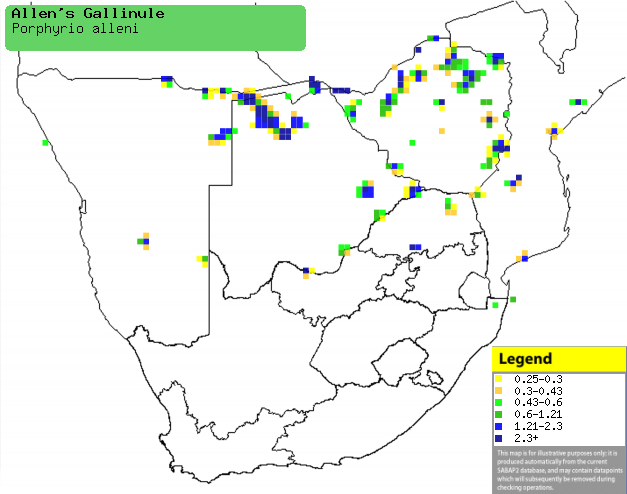|
Porphyrio alleni (Allen's
gallinule,
Lesser gallinule)
[= Porphyrula alleni]
Kleinkoningriethaan [Afrikaans];
Edenene (generic term for gallinules and moorhens) [Kwangali]; Nhapata
(generic name for coot, gallinule, moorhen, crake or rail) [Shona];
Afrikaans purperhoen [Dutch]; Talève d'Allen [French]; Afrikanisches
sultanshuhn [German]; Caimão de Allen [Portuguese]
Life
> Eukaryotes >
Opisthokonta
> Metazoa (animals) >
Bilateria >
Deuterostomia > Chordata >
Craniata > Vertebrata (vertebrates) > Gnathostomata (jawed
vertebrates) > Teleostomi (teleost fish) > Osteichthyes (bony fish) > Class:
Sarcopterygii (lobe-finned
fish) > Stegocephalia (terrestrial
vertebrates) > Tetrapoda
(four-legged vertebrates) > Reptiliomorpha > Amniota >
Reptilia (reptiles) >
Romeriida > Diapsida > Archosauromorpha > Archosauria >
Dinosauria
(dinosaurs) > Saurischia > Theropoda (bipedal predatory dinosaurs) >
Coelurosauria > Maniraptora > Aves
(birds) >
Order: Gruiformes > Family: Rallidae
Distribution and habitat
Occurs in patches of sub-Saharan Africa; in southern Africa it is locally common in north-eastern Namibia (including
the Caprivi Strip), northern and south-eastern Botswana, Zimbabwe, central
Mozambique and north-eastern South Africa. It generally prefers freshwater
marshes and reedbeds, flooded grassland, flood plains and rank grass bordering
on large water bodies.
|
 |
|
Distribution of Allen's gallinule in southern
Africa, based on statistical smoothing of the records from first SA Bird
Atlas Project (©
Animal Demography unit, University of
Cape Town; smoothing by Birgit Erni and Francesca Little). Colours range
from dark blue (most common) through to yellow (least common).
See here for the latest distribution
from the SABAP2. |
Predators and parasites
- Predators
- Crocodylus niloticus (Nile crocodile)
Movements and migrations
Complex and not well understood, it is thought
to be resident at permanent water bodies, while others migrate to
seasonally flooded areas in the period from December-April.
Food
Mainly eats plant matter, supplemented with invertebrates
and fish, doing most of its foraging in the early morning and late afternoon,
walking on floating vegetation and plucking fruit from low bushes. The following food items have been recorded
in its diet:
- Plants
- fruit
- Machaerium lunatum (legume)
- flowers and seeds
- reeds
- sedges
- water lilies
- grasses
- bulbs and stems of water plants
- Animals
- invertebrates
- molluscs
- crustaceans
- insects
- earthworms
-
spiders
- fish
Breeding
- Monogamous, territorial solitary nester, with nests usually spaced far
apart.
- The nest (see image below) is a loosely built cup of reeds, leaves, dry
sedges, grass and other aquatic plants, often woven into a clump of reeds,
grass or tangled vegetation, effectively concealing it.
 |
|
|
Allen's gallinule at its nest, Sericea
farm, South Africa. [photo
Warwick Tarboton ©] |
|
- Egg-laying season is from December-May, peaking from January-March.
- It lays 2-8 eggs, which are incubated by both sexes for about 15 days.
- The chicks leave the nest soon after hatching and fed and cared for by
both parents, taking their first flight at approximately 55 days old.
Threats
Not threatened, although wetland modification may have
negatively affected its population.
References
-
Hockey PAR, Dean WRJ and Ryan PG 2005. Roberts
- Birds of southern Africa, VIIth ed. The Trustees of the John Voelcker
Bird Book Fund, Cape Town.
|
